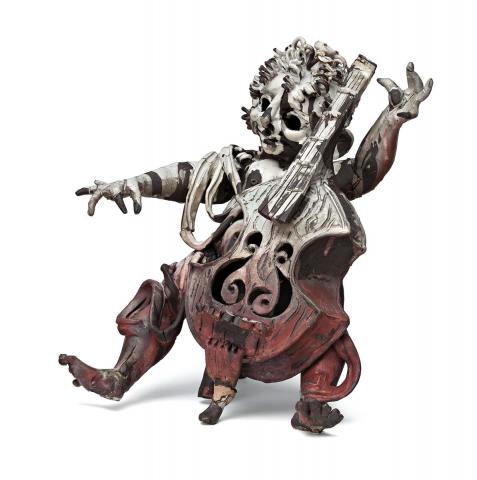CELLO PLAYER, c.1958 – 59
JOHN PERCEVAL
glazed earthenware
40.0 cm height
Terry Clune Galleries, Sydney
The Estate of the late James O. Fairfax AC, New South Wales
Possibly: The Angels of John Perceval, Terry Clune Galleries, Sydney, May 1959, cat. 13 (as ‘Cello Player’)
Thomas, D., ‘The Art Collectors 3: James O. Fairfax’, Art and Australia, Ure Smith, Sydney, vol. 3, no. 4, March 1966, pp. 256 (illus.), 257
Angel with Cello, 1957, earthenware with copper oxide glaze, 30.3 cm height, in the collection of the National Gallery of Australia, Canberra.
John Perceval’s ceramic Angels are highly sought-after items whenever they appear on the market. Such was the impact of their first exhibition in 1958 at John Reed’s Museum of Modern Art that Bernard Smith pronounced it to be ‘one of the most important one-man shows held in Australia since the war … (which) revealed him as an artist with an observant eye and keen wit.’1 Apart from displaying a compelling and mischievous spirit, the Angels are also marvellous examples of technical skill and prowess, reflective of the previous decade Perceval spent in partnership with his brother-in-law Arthur Boyd at their Murrumbeena business, AMB Pottery. Whilst earlier examples tended to lack fine detail, pieces from the second series (of which Cello Player, c.1958–59 is one) feature finely articulated fingers and delicately curled hair. A photo of Perceval and his children from 1958 shows one work in progress ‘balanced atop three small balls of clay, which were subsequently removed before firing … The hair, according to his then wife Mary, was spun (around chopsticks) by the artist like fine Chinese noodles.’2 The richly coloured glaze is worth noting too, the result of the artist’s pursuit of an elusive ancient Chinese recipe known as sang-de-boeuf, a green glaze that turns red and gold as the heat within the kiln is lowered.
Perceval worked on the Angels over a number of years and exhibited one selection as part of the historically significant exhibition The Antipodeans in 1959. It is well known that friends such as Barry Humphries, Mirka Mora and Charles Blackman inspired some of the figures, as did Perceval’s children and his memories of his own childhood. Given this, they veer between innocence and delinquency, yet there is also an attitude of frank, bacchanalian joy and excess about them, as if they were unruly sprites hanging around a tavern. In this, Helen Brack, whose husband John was a key member of the Antipodean group, gives a salutary reminder that Bohemia was also Perceval’s subject and ‘a statement against middle-class morality and bourgeois respectability, such as Barry Humphries did for the word 'nice'. The Angels were imps, something like Shakespeare’s ‘Puck’. Perceval also delighted at snubbing officialdom (and wanted to be) funny, incongruous… to go outside respectability. He would have had no difficulty in seeing the cello as Female and related to Sex, by visual analogy, not by anything intellectual.’3
Many of the Angels series are now held in the collections of the National Gallery of Australia, National Gallery of Victoria, and the State galleries of South Australia, New South Wales and Western Australia; and as prized items within important corporate and private collections. As a result, few appear on the open market with only eight examples appearing since 2000. The most recent of these was Acrobat Angel, c.1958 from The Gould Collection, which sold for $97,600 through Deutscher and Hackett in March 2017.
Many thanks to Helen Brack for her assistance with this essay.
1. Smith, B., ‘The Antipodean Artists’, The Critic as Advocate: selected essays 1948-1988, Oxford University Press, Melbourne, 1989, p. 146
2. Smith, D., Delinquent Angel: John Perceval’s Ceramic Angels, Shepparton Art Museum, Victoria, 2014, p. 11
3. Brack, H., e-mail to the author, 20 June 2017
ANDREW GAYNOR
Australian art specialist, writer and researcher
